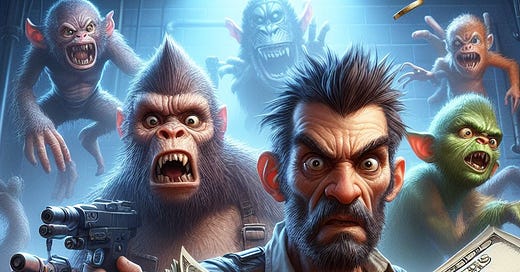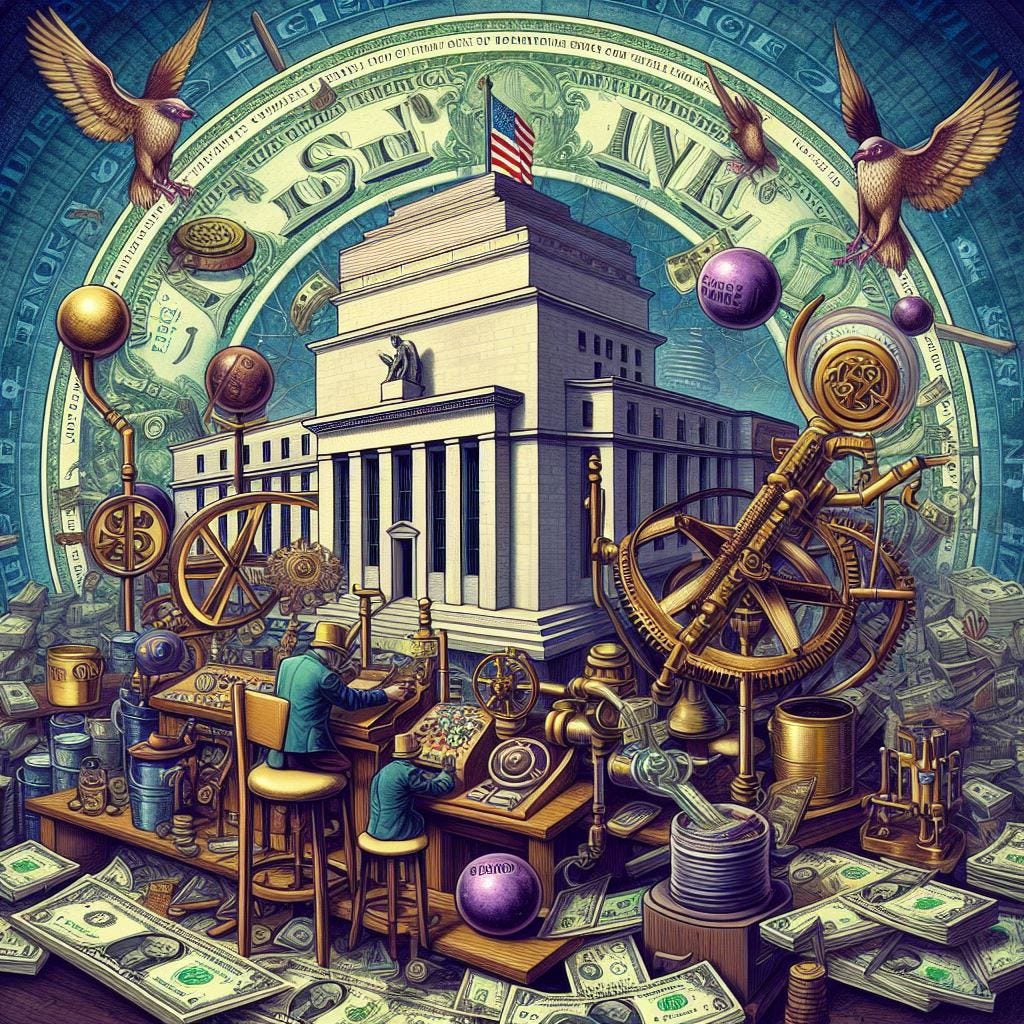What if... The Fed Reversed the Mandrake Mechanism?
Is inflation a side effect of the Mandrake Mechanism and what would happen if "reverse inflation" took hold.
Today, we face a question about the liquidity of the US dollar.
It is the known world reserve currency and has buying power beyond the borders of the United States and its trading partners. Every country in the world holds a reserve of United States Dollars to allow for any of their economic opportunities to be exchanged into and out of their local currency and into Greenbacks.
As the Mandalorian says, “This is the way. “
To make the opportunity to sell and exchange goods and services for a form of medium that everyone wants to trade for; oh, to be loved and wanted, lusted for, and maybe even killed for.
Money. Filthy lucre. Scratch. Call it what you want - it makes everything go around.
It turns out that we all need it a lot more than it needs us, and therefore, it’s important to keep this in mind as we grind toward late-stage capitalism.
It’s this generation that will face an awful monster known as inflation.
I just rewatched Ghostbusters. It's an all-time great movie with fantastic acting. It has a compelling plot and funny punchlines that don’t have to age well to be still funny.
But then something happens in the first act: the Ghostbuster gets the call to the hotel and crashes through the dining hall to catch Slimer. Afterward, they present the bill to the hotel manager for $5,000.
“I had no idea it would be so extravagant; I won’t pay!” the manager exclaims. After they grumble and fein-release the specter, the manager relents, and the monologue into the second act begins.
$5,000. Five-thousand dollars.
Five Grand. Five K. Five Large. A Nickel. The Grip Squad.
Okay, that last one, maybe not, but five thousand remains a lot of money, even in 2024.
I fixated on this amount in both the past and current values. Let’s think about how much that amount would've bought in today’s dollars, but remember the large amount of money it was even back then.
I wondered a lot about how, after less than I’ve been alive, our buying power in a supposed prosperous country could d have eroded so much yet still retain such a cornerstone price point in our collective minds.
According to inflation calculations, $5,000 in 1984 equals approximately $14,933.88 in 20241. This means that the purchasing power of $5,000 has decreased due to inflation over these 40 years. The average annual inflation rate during this time was about 2.77%1. These are approximate values, and actual amounts may vary slightly.
Inflation explained.
Inflation is the rate at which the general level of prices for goods and services rises and, subsequently, purchasing power falls. To keep the economy running smoothly, central banks attempt to limit inflation and avoid deflation.
The Federal Reserve, often called the “Fed,” plays a crucial role in managing inflation and creating money. Here’s a simplified explanation of the process:
Debt Obligations: The U.S. Treasury issues debt obligations, known as Treasury bonds, to finance government spending. These bonds are IOUs that promise to pay back the amount borrowed, with interest, after a certain period.
Money Creation: The Federal Reserve, as the central bank, can buy these Treasury bonds. When the Fed does this, it creates money “out of thin air” to pay for these bonds. This is often what people mean when they say the Fed “prints money,” although, in reality, most money is digital, and no physical printing occurs.
Selling to Banks: The newly created money doesn’t go directly into the economy. Instead, it buys Treasury bonds from banks and other financial institutions. This increases banks' reserves, increasing their lending capacity.
Circulation: Banks can then lend this money to businesses and individuals. This is how the newly created money enters the broader economy. The process of lending and spending can lead to an increase in the overall money supply, which can contribute to inflation if it outpaces economic growth.
Markup for Consumer Purchase: Banks and money services mark up the cost of money (i.e., charge interest) when they lend it out. This is how they make a profit. The interest rate is often influenced by the federal funds rate, which the Federal Reserve sets.
It’s important to note that while this process can contribute to inflation, it’s not the only factor. Various elements influence inflation, including demand for goods and services, production costs, and government policy. The Federal Reserve uses multiple tools to manage inflation and keep the economy stable, not just control over the money supply. For example, it can raise or lower the federal funds rate to influence borrowing costs and spending levels.
This is a simplified explanation, and the actual process involves more complexities and nuances. Also, the relationship between money creation, debt, and inflation is a topic of ongoing research and debate among economists.
Now, taking center stage!
Mandrake, the Great!
Money-Magician Extraordinaire!
The “Mandrake Mechanism” is a term used to describe how the Federal Reserve creates money. Here’s a simplified explanation:
Creation of Money: The Federal Reserve creates money out of nothing1. This is often called “printing money,” although most money is digital, and no physical printing occurs.
Usury: Usury is applied as the interest payment on these "pretended loans"1. These are not actual loans but rather the money created by the Federal Reserve.
Inflation: The creation of money in this way can lead to inflation, sometimes referred to as a "hidden tax"1. Inflation is the decrease in the purchasing power of money, which happens when the supply of money increases faster than economic growth.
Boom-Bust Cycles: The Federal Reserve’s actions can also create boom-bust cycles1. By manipulating interest rates and the money supply, the Federal Reserve can influence economic activity, leading to periods of economic expansion (booms) followed by economic downturns (busts).
This is a simplified explanation, and the actual process involves more complexities and nuances1. Also, the relationship between money creation, debt, and inflation is a topic of ongoing research and debate among economists1.
The Mandrake Mechanism, a term that describes how the Federal Reserve creates money, can significantly affect inflation and interest rates over time.
Inflation: Creating money “out of thin air” increases the money supply. If this increase outpaces economic growth, it can lead to inflation, which is a rise in the general level of prices of goods and services1. Inflation erodes purchasing power, meaning each currency unit buys fewer goods and services. This is sometimes referred to as a "hidden tax"2.
Interest Rates: The Federal Reserve uses the Federal Funds Rate (the interest rate at which banks lend reserve balances to other banks overnight) to control inflation. When the Fed wants to reduce inflation, it raises the federal funds rate. This makes borrowing more expensive, slows economic activity, and reduces inflation1. Conversely, when the Fed wants to stimulate the economy, it lowers the federal funds rate, making borrowing cheaper and encouraging spending1.
Boom-Bust Cycles: By manipulating the money supply and interest rates, the Federal Reserve can also create boom-bust cycles2. During a boom, the economy grows, potentially leading to inflation. To combat this, the Fed might raise interest rates, which can then lead to a bust or economic downturn2.
It’s important to note that these are general trends. The actual impact of the Mandrake Mechanism on inflation and interest rates can vary based on various factors, including fiscal policy and global economic conditions.
Now, What if the Fed Burned Dollars instead of Printing them?
We are now at the part of the magic show where it takes a turn.
Here, the magician takes a few dollars, flips his hands, doubles the amount from tens to hundreds, and then flips them back—to wave them back at you, taunting you with bills you could pay off or even the weekend getaway that a few thousand suddenly would make a reality.
Now, the magician takes a lighter from his pocket. He’s being careless and talking at the audience as he flicks the brass open and sparks, and suddenly, POOF!
Flames roared around his hands! A gasp shakes through the audience, and we all cry out!
The fan of hundred-dollar bills is gone in a puff of flames, leaving a few ashes of flash paper, which are now limping through the air to the ground.
The Magician is the Fed. You and I are in the cheap seats, but now that we know about the mandrake Mechanism, we know precisely how the magician does it.
The idea of the Federal Reserve “burning” money to combat inflation is a metaphorical concept rather than a literal one. In reality, the Fed doesn’t physically destroy currency to control inflation. Instead, it uses various monetary policy tools to manage the money supply1. Here’s how it works:
Open Market Operations: The primary tool the Fed uses to control the money supply is open market operations, which involve buying and selling government securities1. It sells government securities when the Fed wants to reduce the money supply (and combat inflation). This effectively “removes” money from the economy as banks pay for these securities1.
Interest Rates: The Fed can also influence the money supply by adjusting the federal funds rate, which is the interest rate at which banks lend reserve balances to other banks on an overnight basis1. Higher interest rates make borrowing more expensive, which can reduce the amount of money in circulation as there is less borrowing and spending1.
If the Fed were to agressively remove money from the economy, it could potentially lead to a scarcity of dollars in circulation. This could slow economic activity and potentially lead to deflation (a general decrease in prices) if taken to an extreme1. On the other hand, if the Fed does not remove enough money from the economy, it could lead to continued inflation.
What if, the Fed Burned us back to 1984?
It’s important to note that managing the money supply is a delicate balancing act. The Fed must be careful to avoid causing too much economic disruption while still achieving its goals of price stability and maximum employment.
Theoretically, the Federal Reserve could use contractionary monetary policy to reduce the money supply, increasing the dollar's value. However, returning to the exact valuation of 1984 would be highly complex and likely not feasible for several reasons:
Economic Conditions: The economic conditions of 1984 were unique to that time period, and influenced by a multitude of factors, including technology, productivity, global trade, and fiscal policy1. It would be nearly impossible to recreate these conditions today.
Inflation Targeting: The Federal Reserve targets an inflation rate of around 2% per year2. This is considered a healthy rate of inflation that allows for economic growth. Deflation, or negative inflation, can lead to financial problems such as decreased consumer spending and increased debt burdens.
Potential Consequences: Aggressively reducing the money supply could lead to a scarcity of dollars in circulation, potentially causing economic disruption. For example, it could lead to deflation, higher interest rates, reduced investment, and slower economic growth3.
Global Impact: The U.S. dollar is an international reserve currency, and drastic changes to its value could significantly impact global trade and financial stability.
The Federal Reserve uses various tools to manage inflation and stabilize the economy, such as adjusting the federal funds rate and conducting open market operations3. These tools carefully balance the goals of maximum employment, stable prices, and moderate long-term interest rates3.
###
Until the Next Runaway Train of Thought
###






